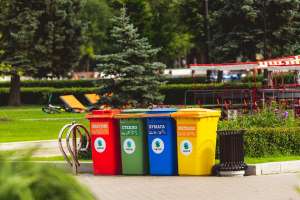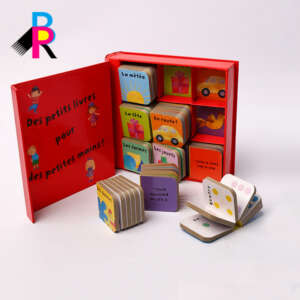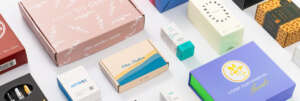As we all know boxes come in many shapes and sizes, but how do you know which packaging option is best suited for your product?
Just like choosing the right packaging company for your business, your packaging type and design plays a crucial role in the functionality of your products!
In simple terms, serving your food in packaging meant for cosmetics may not benefit your product or brand. It will leak, ruin your artwork designs and isn’t very user friendly for your customers!
Optimizing your packaging styles will offer optimal product presentation, protection and a boosted customer experience.

Let’s delve deeper into the basics that will lay the foundation for your packaging choices!
Determining your Budget
Your budget will determine what material, structure, volume and shipping services you will choose to utilize.
Custom packaging can be a little mysterious in terms of pricing as the cost is highly dependent on your customization choices, which we will get into a little later in this post.
While it may seem appealing to go with the most affordable packaging options, this may actually be detrimental to your product’s safety as well as your branding.
It’s important to note that more durable boxes will prevent products from breaking and in turn costing you extra in re-production.
Not to mention, if a customer receives a broken product, they may not want to buy from you again, putting your customer satisfaction at risk.
So, if you’re looking to opt for unique designs, it’s important to include the cost of structural design services into your budget in order to ensure your products are safe and sound within new innovative shapes.
Keep in mind that opting for standardized structures is a foolproof way to ensure your products safety and in turn can end up saving on costs for your business.

Higher quality box structures can also help save you money through labour costs, as better boxes tend to be quicker and easier to construct.
More importantly, a higher-quality, well-designed custom box will provide a better experience for your customer, helping you stay in their mind and incentivize repeat purchases, in turn boosting your sales.
Exploring Packaging Materials
When choosing material for your packaging, you must consider your product and the journey it will go on before it reaches your customer.
Most packaging for boxes will be paper, at least in some form, but each style holds different benefits and fits some products better than others.
Below, we list some of the more common materials used for boxes as well as some of their benefits and appropriate applications.
Paperboard
Paperboard, or folding carton, is the perfect solution if you are looking for a cost-effective material for your custom made boxes.
Paperboard packaging is increasing in popularity among both product manufacturers and retailers for its numerous benefits.
Folding cartons are very flexible and easy to fold, making it ideal for a wide array of products and structures.

Most popular for lightweight products sold in-store, these cartons are compatible with multiple printing options, allowing for plenty of customization so you can show off your brand and really make an impact on any shelf.
Consumers tend to gravitate more to paperboard packaging, with a recent study showing that 68% of consumers prefer this material in their packaging.
Why do consumers prefer paperboard? Because it is environmentally friendly, it’s convenient when handling, and it’s overall aesthetically pleasing.
Paperboard comes in a few different materials, including:
- Solid Bleached Sulfate (SBS) has a clay-coated surface on top of multiple plies of bleached virgin softwood or a blend of softwood and hardwood fibre.
- Coated Unbleached Kraft (CUK) is a combination of unbleached virgin kraft fibre and different southern pine species with some hardwood fibre.
- Coated Recycled Paperboard uses recycled fibre recovered from paper manufacturing, converting facilities, and post-consumer sources in its construction.
Corrugated Cardboard
Corrugated cardboard is incredibly durable and made from an arched paper design known as fluting, which sits between two liners.
Due to its durability, it is the preferred packaging choice for products that need some extra protection.
The structure of corrugated custom boxes provides an extra cushion for your product, a benefit that is essential if you are shipping breakable products.
On top of being very durable, this material option is also very customizable, coming in different sizes and thicknesses if you need more support for your product.
The malleable consistency allows for many different box shapes that fit just about any product.

The available printing options are also very versatile, allowing for additional branding opportunities through high-resolution graphics printed directly onto or into your packaging!
The most significant benefit of corrugated custom boxes is their price – they are one of the most affordable available materials, and they are recyclable!
Rigid Boxes
Rigid boxes are very thick paper-based boxes consisting of chipboard wrapped in decorative specialty paper.
One of the more expensive packaging options, rigid boxes bring an air of luxury to your product, thanks to their top-quality construction.
You will typically find these boxes housing board games, smartphones, and other luxury goods since they are incredibly sturdy.
Unlike any other packaging, rigid boxes are structured with paper precisely wrapped around solid boards and each board is hand glued together to create a box.
There are two types of rigid boxes:
- Full finish rigid boxes have an additional layer of wrapping that you can customize to provide your customer with a memorable experience.
- Partial finish rigid boxes are made with a single piece of chipboard without the additional interior layer, leaving the chipboard material exposed

Though rigid boxes are one of the more expensive options out there, they provide the perception of value to whatever they hold.
Because of their quality construction and gift-like feel, customers tend to hold onto the boxes for storage or even as a decorative element in their homes.
Comparing Packaging Styles
There is a wide range of packaging styles, with each made to hold specific products, especially in the custom packaging world.
Each packaging comes in different prints, finishes, and materials, so you can create the perfect custom packaging for your product and brand.
Let’s discuss some of the most popular packaging styles on the market today to help give you a better idea of what you might be looking for.
Every box on this list is fully customizable and available in a wide range of colours and sizes to ensure you can find something that fits your branding, product and initiative!
Here are some package styles to consider:
Folding Carton Styles
Tuck End Boxes vs. Tuck End Auto Bottom Boxes
Straight Tuck End boxes can be constructed manually or in an automated assembly line and are great for products that require a large window with a front display panel.
They have a clear display window with a custom cut out option if you want the window to show off a product with a unique shape or design.
This design is easily opened and closed and suitable for on store shelves thanks to the display window and easily stackable shape.
The Reverse Tuck End box is very similar in shape to the Straight Tuck End box.
Like the Straight Tuck End box, this box shape has a display window with a custom cutout option, is easy to open and close, and is ideal for store shelves.
The Reverse Tuck End structural design feature offers an opportunity to differentiate from your competitors and offer a more interesting customer experience!
While Tuck End Auto Bottom boxes look very similar in construction to straight tuck end boxes and reverse tuck end boxes, their construction differs a little bit.
The only real big difference between these styles is that the tuck end auto bottom boxes are constructed in a way that allows you to lock the bottom of the box without using any tape or glue.

This allows for shorter assembly times and a more sturdy bottom to the box for items that may be a little bit heavier, such as perfumes.
Display Boxes & Sleeves
The Display Box is unique, cost-effective, innovative, and easy to assemble.
This box shape is suited for light-weight products such as snacks and medical products and offer an extra layer to your branding capabilities.
Display boxes are designed to hold your products while also promoting what’s inside through the pop up structural design feature.
This structural design feature allows for more surface area to promote your brand, communicate with your customers and create an overall narrative for your products!
Sleeves sit around boxes and provide additional branding opportunities and sealing capabilities.
There is no top or bottom; instead, it acts as an extra layer of insulation, branding or simply used for extra sealing capabilities for things like display boxes.
While this may seem like an unnecessary accessory, this is a great option to consider especially if you choose to opt for more generic packaging for cost saving purposes!
This option will help boost your packaging’s quality and provide a better experience for your customer.
Corrugated Box Styles
Regular Slotted Boxes vs. Mailer Boxes
Regular slotted corrugated boxes are probably what you see when you think of your basic shipping package.
If you’ve ever moved properties, it’s likely you’ve used regular slotted boxes to pack your belongings.
Regular slotted boxes offer exceptional support to heavier weight products and offer a lot of durability especially in a variety of different shipping conditions.
The bottom has to be hand tapes together, but the great thing is, they can also be shipped flat, making it more cost effective and convenient to ship in bulk.
On the other hand, mailer boxes have also gained immense popularity in the e-commerce industry.

This packaging is specifically designed to store and ship products long distances.
Thanks to their structural design features of interlocking flaps and wings, mailer boxes do not require additional glue or tape for packaging items.
Both of these styles are great options for shipping products, which one is more suited to your product is really up to preference.
Mailer boxes are exceptionally popular for subscription box businesses while regular slotted boxes are commonly used for shipping larger and more heavy weight items.
Gable Boxes vs. Carriers
The Gable Box is available in either corrugated cardboard or paperboard, so you can decide if you want your box to be more durable or more aesthetically pleasing.
The box has a convenient handle that makes traveling with it a breeze, similar to what you would find on a take out container for food.
This food-safe option allows for heavy loads or liquids such as milk or juice, though its durable design is also suitable for non-food items.
This packaging structure is very functional as wax coatings can be added to avoid any grease marking or leaking, making this an optimal structure for take-out food services!
Carrier Packs on the other hand, have six slots and are for transporting drinks such as coffee or any canned beverages.
Like the Gable Box, the pack is available in corrugated cardboard or paperboard and has a handle for easy transportation.
This corrugated shape is optimal for independent craft beer factories, coffee shops, or other businesses that sell beverages to go.
Kraft Mailers
Kraft mailers on the other hand are made from durable brown kraft paper. Kraft paper mailers have gained popularity more recently with eco-friendly initiatives taking the industry by storm.
Kraft mailers are a great alternative to plastic mailers as they are made from recycled material and tend to be 100% recyclable too.
kraft paper mailers feature high tear resistance and tend to do really well for packaging apparel while maintaining and pursuing sustainable narratives.
Looking at Packaging Ergonomics
Whether your product is in a store or sold online, you always want your package to stand out and leave an impression.
The design of your package will ultimately dictate what your customers think of your company, so planning a compelling custom box design that encapsulates your brand is a must.
Nowadays, the box that holds your product is just as important as the product itself.
Custom boxes can heighten the customer experience and make for unique unboxing experiences that will ensure your brand remains in the mind of anyone who opens your packaging.
While a custom-made box does improve the customers’ experience, it also provides you with additional branding opportunities, so it’s a win-win!
When picking your custom boxes, it is crucial to understand the industry your product is entering.
Knowledge is power, so do some research and see what your competitors are doing by looking at things such as the box shape, the material of their boxes, and the design choices they have made.
You want to see what works in your field and see what is getting a response.
Pick a design, send it out in small quantities, and see how your customers react before leaping towards mass production of your custom packaging.
Most custom packaging companies will offer samples of your designs before sending it out for production.
Although these can sometimes be lower in quality with regards to printing, you can still get a good idea of how your packaging will sustain itself in certain circumstances.
You can also send these samples out to your loyal customer base to get valuable feedback on your design, structure and much more.
After all, the customer is always right!

Picking the right packaging for your product should not be a quick and easy process.
Your box structure and design is your chance to make an impression on your customers, so make it count!
Taking Transportation into Consideration
It is necessary to understand your box structure when picking a transport option as it could affect which one is most applicable to you.
If your box structure isn’t very durable, your options will be limited, so it’s best to spend extra time on the packaging as it will better protect your product through the shipping phase.
You also must consider your budget and your product when determining which transportation you use to ship your product.
Airfreight
Airfreight is a transportation solution used by companies that need their product transported as soon as possible.
However, it is also one of the more costly options because of airport taxes and other additional fees.
This transportation option is safe and convenient.
However, only certain goods are suitable for air transport due to customs restrictions and other regulations.
If you decide to go with Airfreight, you will need appropriate packaging for your product.
Your packaging must be capable of dealing with atmospheric changes and environmental exposures, in-transport movement, and shock absorption, so choosing the right packaging for your products is critical.
Road Transport
All packaging will be subjected to road transport at some point during the shipping process.
Road transport is cost-effective, allows for easy monitoring of your products’ location, and is excellent for transporting products across short distances.
Although, you also have to account for traffic, truck breakdown, and weather.
While not as much of an issue as it is with air transport, it is still ideal to have packaging to protect your products efficiently enough to land in your customers’ laps intact!
You have to prepare your packaging for careless driving and the typical vibration that comes with shipping products in a truck or van.

Furthermore, we all know your classic careless delivery man that will simply chuck your packaging wherever it needs to go.
So, make sure your packaging is able to withstand any outside force that may damage your products!
Rail Transport
Rail transport is environmentally-friendly and ideal for heavy products for either domestic or intercontinental transport.
It is relatively reliable and safe while also offering fast delivery at a cost-effective price without worrying about road transport variables such as traffic and weather.
The downside to rail transport is that your packaging needs to be prepared for shunting and vibrating during travel.
Also, railways’ limited routes can be an issue, and if you live far from a depot, you have to consider how to transport your product to the station.
Still unsure which packaging structure is best for your product? Contact our product specialists for expert advice!
Souce: packfactory



